Abstract
The potent kinase inhibitor staurosporine and its protein kinase C (PKC)-selective analogue CGP 41251 are known to sensitise cells with the multidrug resistance (MDR) phenotype mediated by P-glycoprotein (P-gp) to cytotoxic agents. Here four PKC-selective staurosporine cogeners, CGP 41251, UCN-01, RO 31 8220 and GF 109203X, were compared with staurosporine in terms of their MDR-reversing properties and their susceptibility towards P-gp-mediated drug efflux from MCF-7/Adr cells. Staurosporine was the most potent and the bisindolylmaleimides RO 31 8220 and GF 109203X the least potent cytostatic agents. When compared with MCF-7 wild-type cells, MCF-7/Adr cells were resistant towards the growth-arresting properties of RO 31 8220 and UCN-01, with resistance ratios of 12.6 and 7.0 respectively. This resistance could be substantially reduced by inclusion of the P-gp inhibitor reserpine. The ratios for GF 109203X, staurosporine and CGP 41251 were 1.2, 2.0 and 2.9 respectively, and they were hardly affected by reserpine. These results suggest that RO 31 8220 and UCN-01 are avidly transported by P-gp but that the other compounds are not. Staurosporine and CGP 41251 at 10 and 20 nM, respectively, decreased efflux of the P-gp probe rhodamine 123 (R123) from MCF-7/Adr cells, whereas RO 31 8220 and GF 109203X at 640 nM were inactive. CGP 41251 was the most effective and GF 109203X the least effective inhibitor of equilibrium binding of [3H]vinblastine to its specific binding sites, probably P-gp, in MCF-7/Adr cells. Overall, the results imply that for this class of compound the structural properties that determine susceptibility towards P-gp-mediated substrate transport are complex. Comparison with ability to inhibit PKC suggests that the kinase inhibitors affect P-gp directly and not via inhibition of PKC. Among these compounds CGP 41251 was a very potent MDR-reversing agent with high affinity for P-gp and least affected by P-gp-mediated resistance, rendering it an attractive drug candidate for clinical development.
Full text
PDF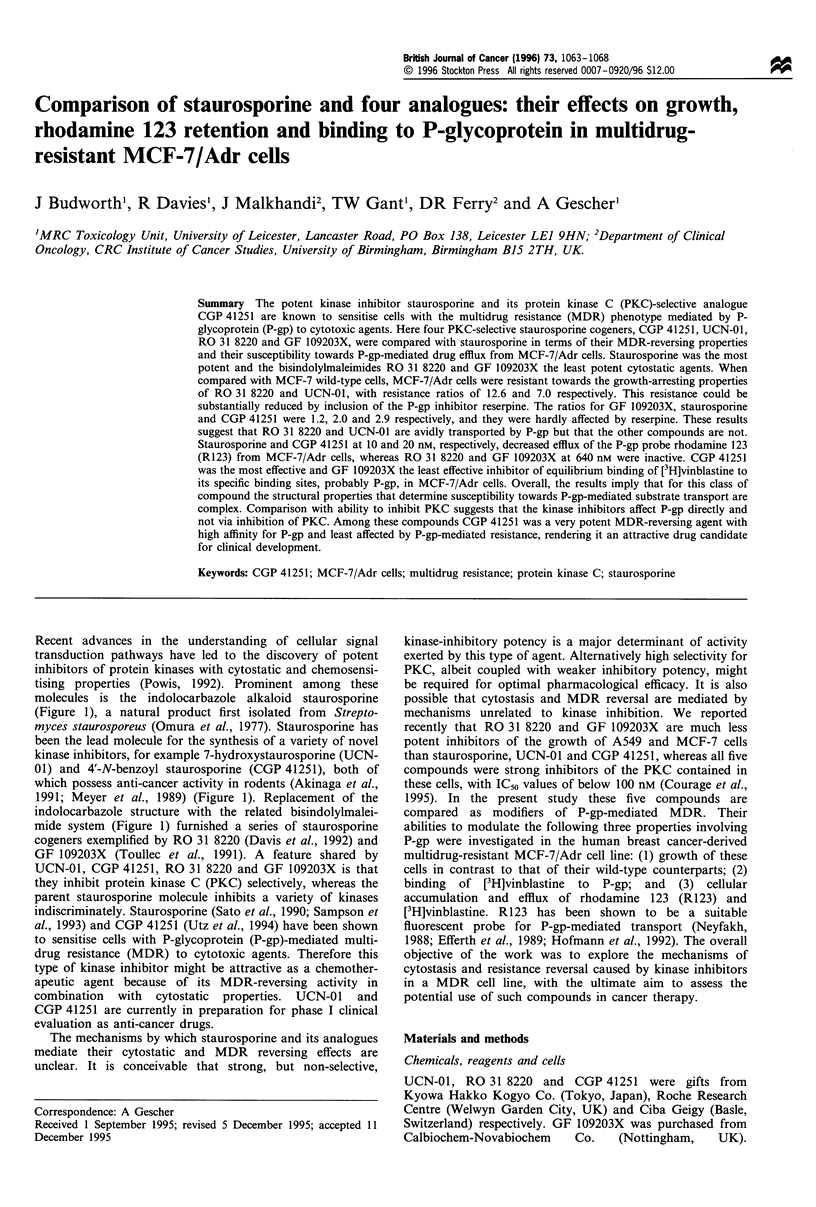
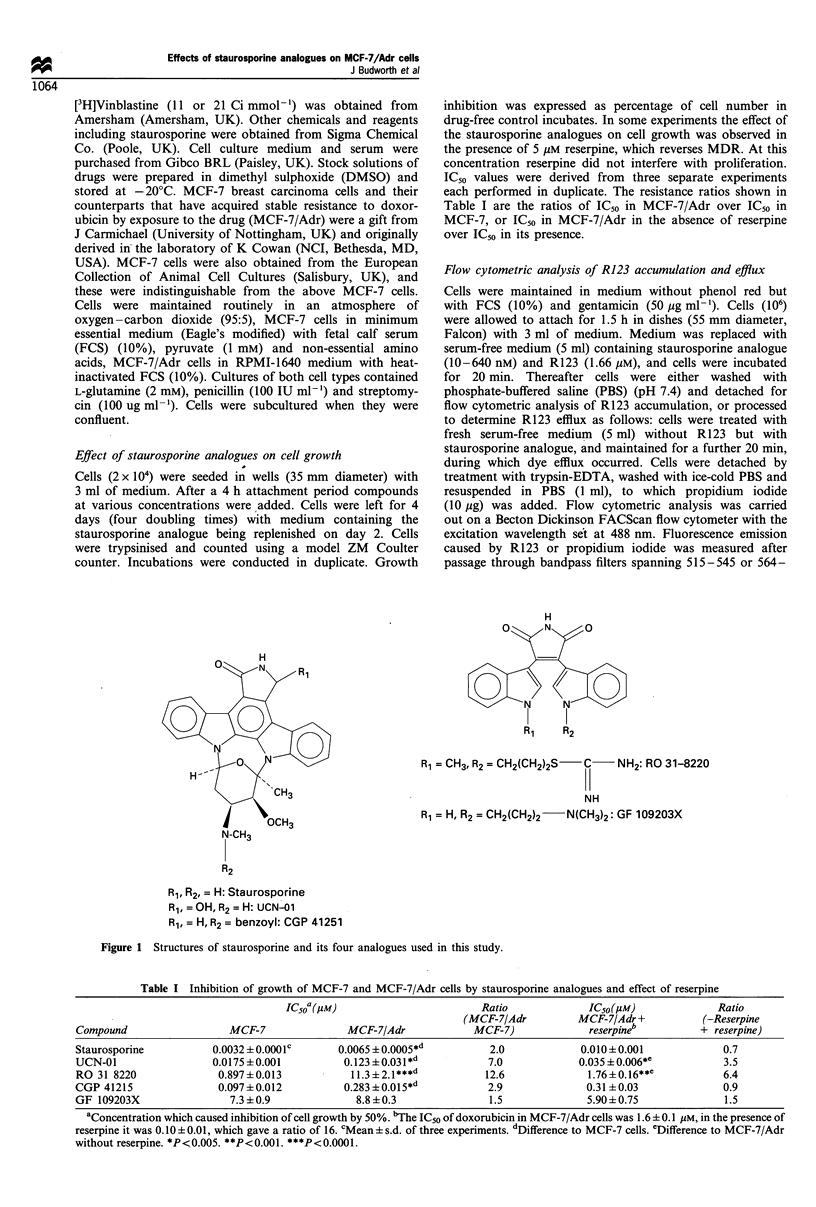
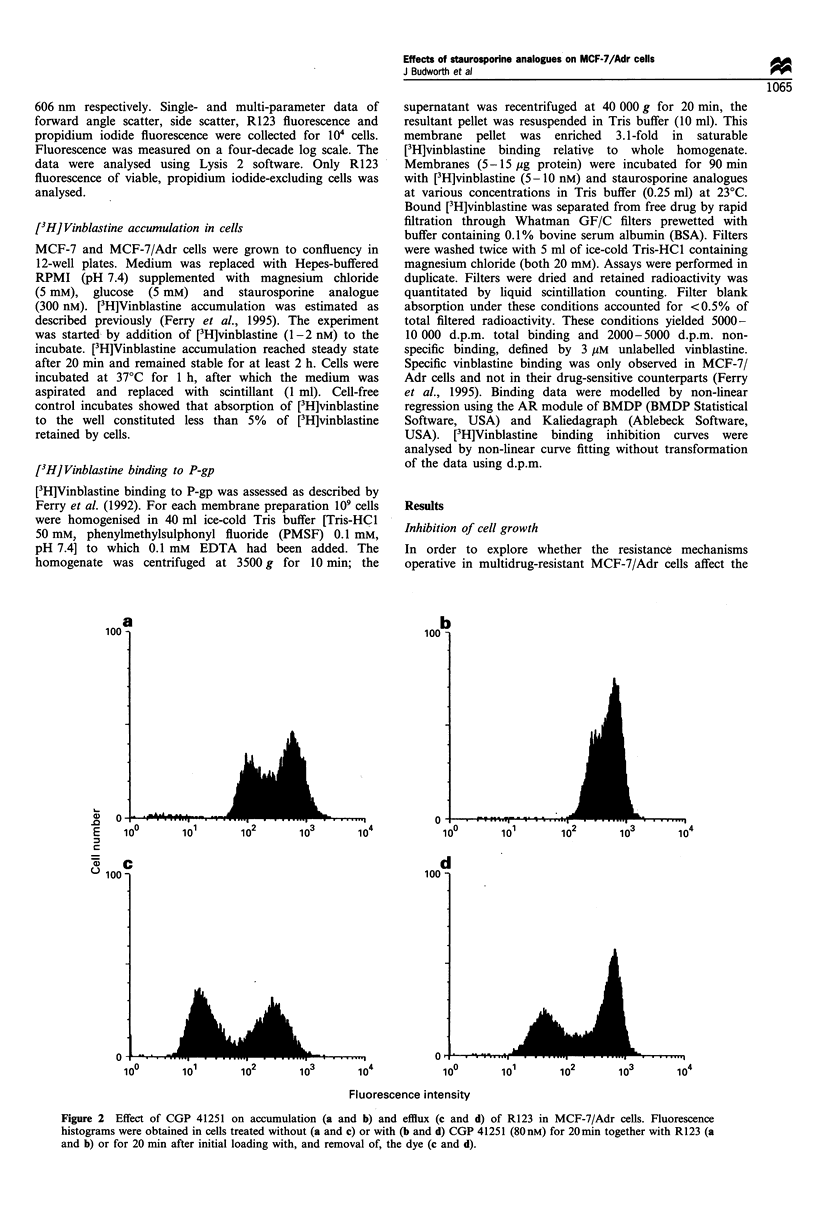
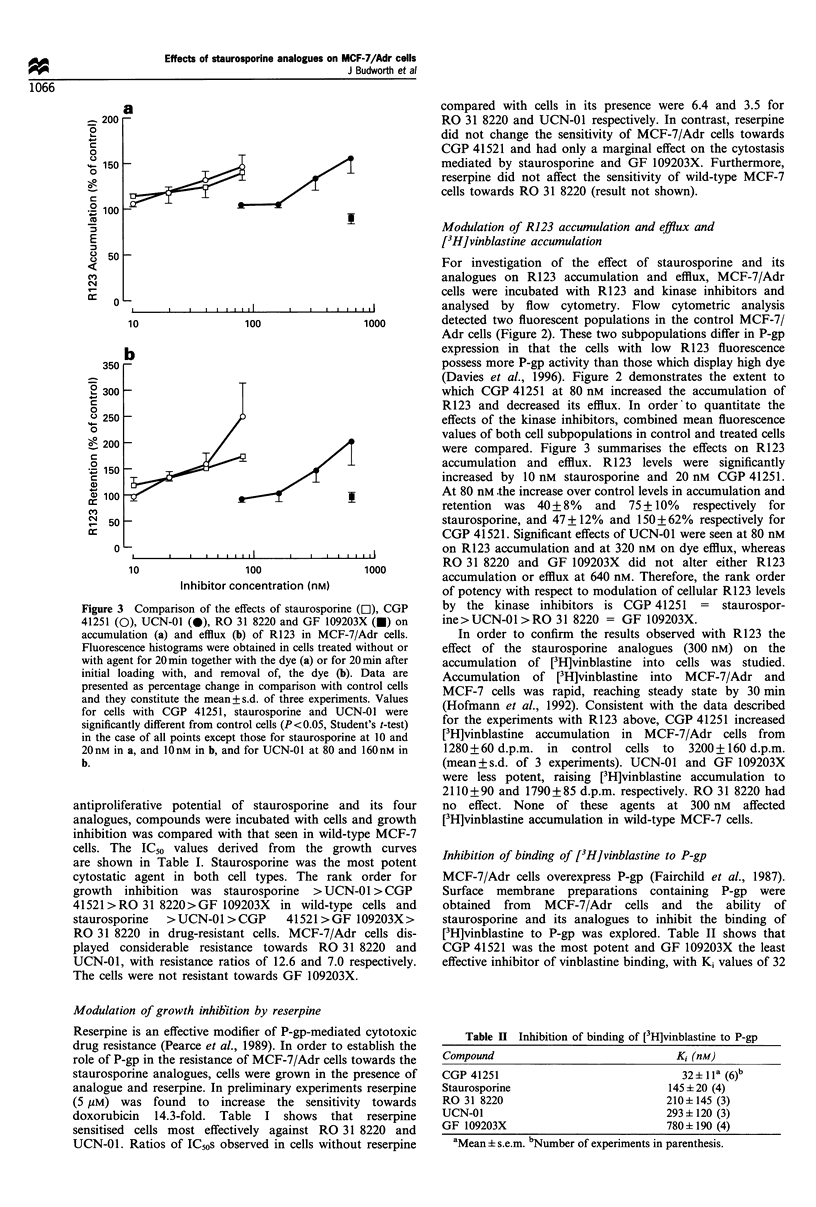
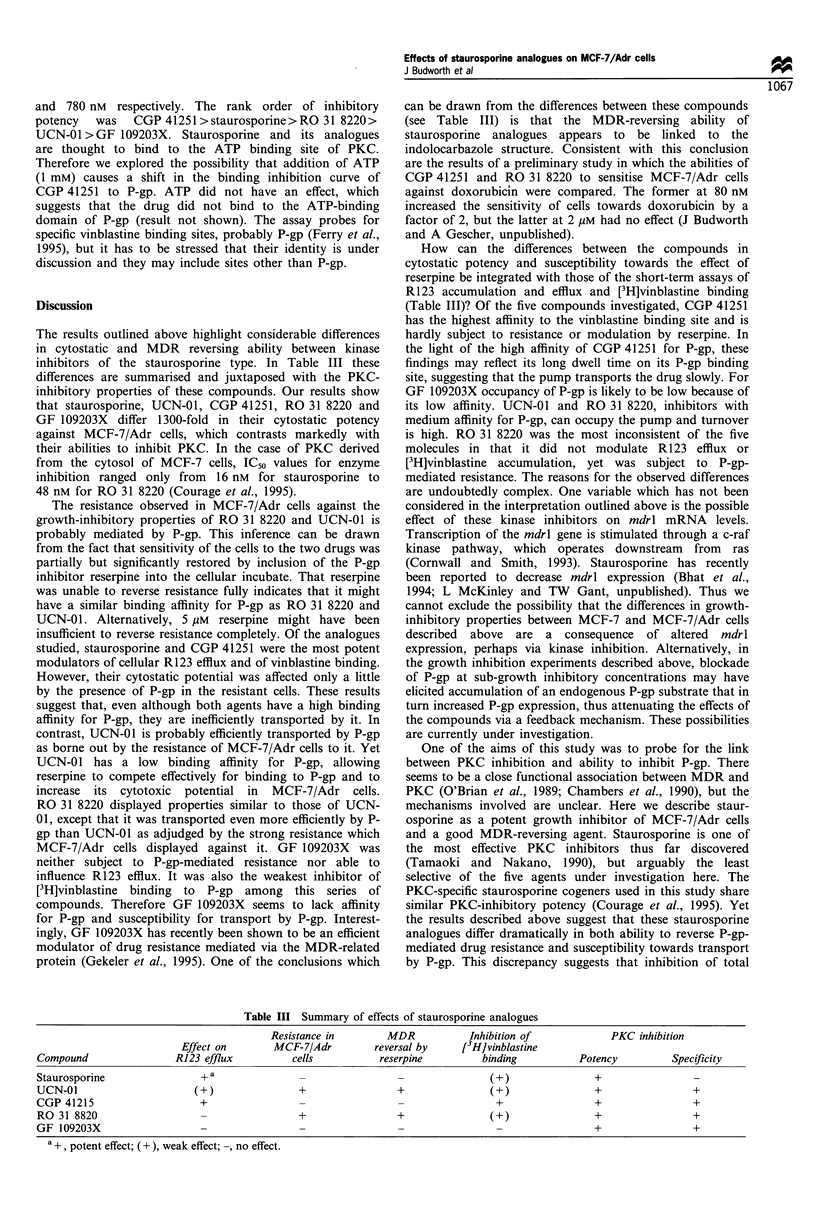
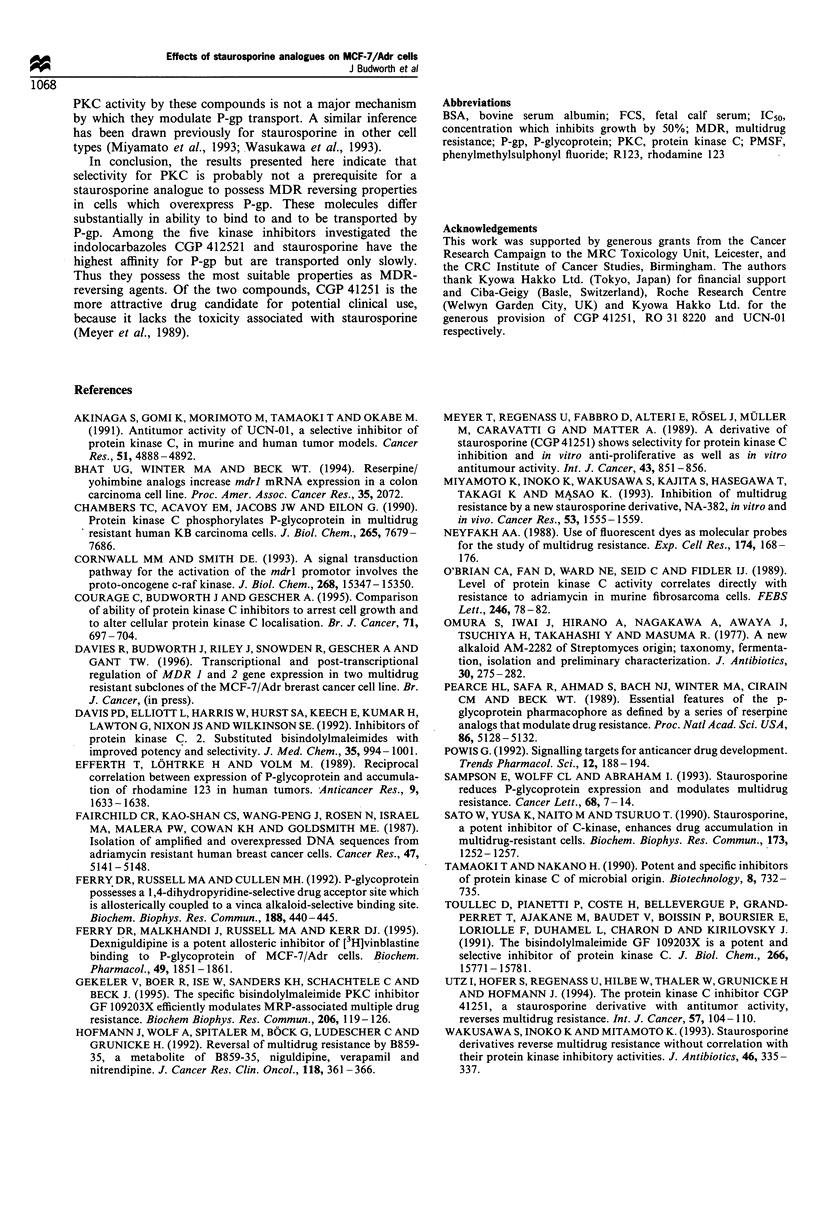
Selected References
These references are in PubMed. This may not be the complete list of references from this article.
- Akinaga S., Gomi K., Morimoto M., Tamaoki T., Okabe M. Antitumor activity of UCN-01, a selective inhibitor of protein kinase C, in murine and human tumor models. Cancer Res. 1991 Sep 15;51(18):4888–4892. [PubMed] [Google Scholar]
- Chambers T. C., McAvoy E. M., Jacobs J. W., Eilon G. Protein kinase C phosphorylates P-glycoprotein in multidrug resistant human KB carcinoma cells. J Biol Chem. 1990 May 5;265(13):7679–7686. [PubMed] [Google Scholar]
- Courage C., Budworth J., Gescher A. Comparison of ability of protein kinase C inhibitors to arrest cell growth and to alter cellular protein kinase C localisation. Br J Cancer. 1995 Apr;71(4):697–704. doi: 10.1038/bjc.1995.137. [DOI] [PMC free article] [PubMed] [Google Scholar]
- Davis P. D., Elliott L. H., Harris W., Hill C. H., Hurst S. A., Keech E., Kumar M. K., Lawton G., Nixon J. S., Wilkinson S. E. Inhibitors of protein kinase C. 2. Substituted bisindolylmaleimides with improved potency and selectivity. J Med Chem. 1992 Mar 20;35(6):994–1001. doi: 10.1021/jm00084a004. [DOI] [PubMed] [Google Scholar]
- Efferth T., Löhrke H., Volm M. Reciprocal correlation between expression of P-glycoprotein and accumulation of rhodamine 123 in human tumors. Anticancer Res. 1989 Nov-Dec;9(6):1633–1637. [PubMed] [Google Scholar]
- Fairchild C. R., Ivy S. P., Kao-Shan C. S., Whang-Peng J., Rosen N., Israel M. A., Melera P. W., Cowan K. H., Goldsmith M. E. Isolation of amplified and overexpressed DNA sequences from adriamycin-resistant human breast cancer cells. Cancer Res. 1987 Oct 1;47(19):5141–5148. [PubMed] [Google Scholar]
- Ferry D. R., Malkhandi P. J., Russell M. A., Kerr D. J. Allosteric regulation of [3H]vinblastine binding to P-glycoprotein of MCF-7 ADR cells by dexniguldipine. Biochem Pharmacol. 1995 Jun 16;49(12):1851–1861. doi: 10.1016/0006-2952(94)00517-p. [DOI] [PubMed] [Google Scholar]
- Ferry D. R., Russell M. A., Cullen M. H. P-glycoprotein possesses a 1,4-dihydropyridine-selective drug acceptor site which is alloserically coupled to a vinca-alkaloid-selective binding site. Biochem Biophys Res Commun. 1992 Oct 15;188(1):440–445. doi: 10.1016/0006-291x(92)92404-l. [DOI] [PubMed] [Google Scholar]
- Gekeler V., Boer R., Ise W., Sanders K. H., Schächtele C., Beck J. The specific bisindolylmaleimide PKC-inhibitor GF 109203X efficiently modulates MRP-associated multiple drug resistance. Biochem Biophys Res Commun. 1995 Jan 5;206(1):119–126. doi: 10.1006/bbrc.1995.1017. [DOI] [PubMed] [Google Scholar]
- Hofmann J., Wolf A., Spitaler M., Böck G., Drach J., Ludescher C., Grunicke H. Reversal of multidrug resistance by B859-35, a metabolite of B859-35, niguldipine, verapamil and nitrendipine. J Cancer Res Clin Oncol. 1992;118(5):361–366. doi: 10.1007/BF01294440. [DOI] [PubMed] [Google Scholar]
- Meyer T., Regenass U., Fabbro D., Alteri E., Rösel J., Müller M., Caravatti G., Matter A. A derivative of staurosporine (CGP 41 251) shows selectivity for protein kinase C inhibition and in vitro anti-proliferative as well as in vivo anti-tumor activity. Int J Cancer. 1989 May 15;43(5):851–856. doi: 10.1002/ijc.2910430519. [DOI] [PubMed] [Google Scholar]
- Miyamoto K., Inoko K., Wakusawa S., Kajita S., Hasegawa T., Takagi K., Koyama M. Inhibition of multidrug resistance by a new staurosporine derivative, NA-382, in vitro and in vivo. Cancer Res. 1993 Apr 1;53(7):1555–1559. [PubMed] [Google Scholar]
- Neyfakh A. A. Use of fluorescent dyes as molecular probes for the study of multidrug resistance. Exp Cell Res. 1988 Jan;174(1):168–176. doi: 10.1016/0014-4827(88)90152-8. [DOI] [PubMed] [Google Scholar]
- O'Brian C. A., Fan D., Ward N. E., Seid C., Fidler I. J. Level of protein kinase C activity correlates directly with resistance to adriamycin in murine fibrosarcoma cells. FEBS Lett. 1989 Mar 27;246(1-2):78–82. doi: 10.1016/0014-5793(89)80257-1. [DOI] [PubMed] [Google Scholar]
- Omura S., Iwai Y., Hirano A., Nakagawa A., Awaya J., Tsuchya H., Takahashi Y., Masuma R. A new alkaloid AM-2282 OF Streptomyces origin. Taxonomy, fermentation, isolation and preliminary characterization. J Antibiot (Tokyo) 1977 Apr;30(4):275–282. doi: 10.7164/antibiotics.30.275. [DOI] [PubMed] [Google Scholar]
- Pearce H. L., Safa A. R., Bach N. J., Winter M. A., Cirtain M. C., Beck W. T. Essential features of the P-glycoprotein pharmacophore as defined by a series of reserpine analogs that modulate multidrug resistance. Proc Natl Acad Sci U S A. 1989 Jul;86(13):5128–5132. doi: 10.1073/pnas.86.13.5128. [DOI] [PMC free article] [PubMed] [Google Scholar]
- Powis G. Signalling targets for anticancer drug development. Trends Pharmacol Sci. 1991 May;12(5):188–194. doi: 10.1016/0165-6147(91)90545-4. [DOI] [PubMed] [Google Scholar]
- Sampson K. E., Wolf C. L., Abraham I. Staurosporine reduces P-glycoprotein expression and modulates multidrug resistance. Cancer Lett. 1993 Jan 15;68(1):7–14. doi: 10.1016/0304-3835(93)90213-s. [DOI] [PubMed] [Google Scholar]
- Sato W., Yusa K., Naito M., Tsuruo T. Staurosporine, a potent inhibitor of C-kinase, enhances drug accumulation in multidrug-resistant cells. Biochem Biophys Res Commun. 1990 Dec 31;173(3):1252–1257. doi: 10.1016/s0006-291x(05)80921-0. [DOI] [PubMed] [Google Scholar]
- Tamaoki T., Nakano H. Potent and specific inhibitors of protein kinase C of microbial origin. Biotechnology (N Y) 1990 Aug;8(8):732–735. doi: 10.1038/nbt0890-732. [DOI] [PubMed] [Google Scholar]
- Toullec D., Pianetti P., Coste H., Bellevergue P., Grand-Perret T., Ajakane M., Baudet V., Boissin P., Boursier E., Loriolle F. The bisindolylmaleimide GF 109203X is a potent and selective inhibitor of protein kinase C. J Biol Chem. 1991 Aug 25;266(24):15771–15781. [PubMed] [Google Scholar]
- Utz I., Hofer S., Regenass U., Hilbe W., Thaler J., Grunicke H., Hofmann J. The protein kinase C inhibitor CGP 41251, a staurosporine derivative with antitumor activity, reverses multidrug resistance. Int J Cancer. 1994 Apr 1;57(1):104–110. doi: 10.1002/ijc.2910570119. [DOI] [PubMed] [Google Scholar]


